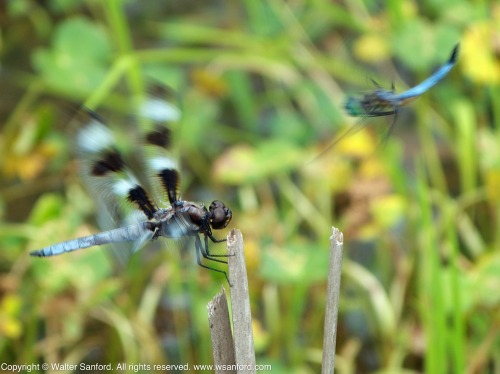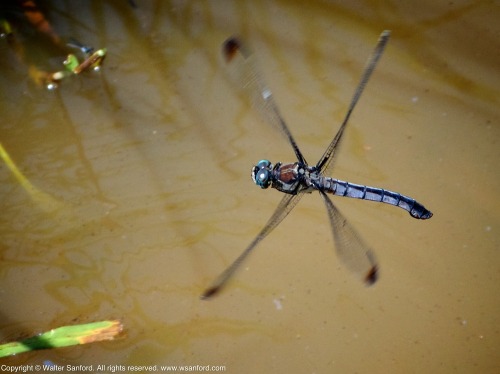It is estimated a dragonfly flaps its wings at about 30 beats per second. I shot several photos of a dragonfly in flight using a shutter speed of 1/1,300 second. Turns out that shutter speed was a little too slow to stop wing motion completely.
I posed the following question to Phil Wherry, my good friend and technology/photography guru: How fast would the camera shutter speed need to be in order to freeze all motion of a dragonfly in flight? Phil’s answer is as follows.
To freeze all motion? Infinitely fast. Even if your exposure is one-millionth of a second long, the wings are going to move a little bit during that interval.
You’re going to get some motion no matter what; the question is simply how much is tolerable. At some point the motion will be small enough that the image will look sharp to you. (This same principle, by the way, applies to depth of field: Focus is only perfect at a single plane no matter what the aperture, but the “depth of field” defines the area where the error is small enough that it’s not obvious.)
We’ll start by considering a simpler scenario. Let’s say you have a motor that makes one full rotation per second. Let’s also say you take a paper plate and draw a thick black line on it, then attach that to the motor shaft. Now you have something that looks a bit like a one-handed clock, with the “hand” making one full rotation every second.
Now, let’s say you point your camera at this setup. If you take a one-second exposure, the “hand” will rotate once during the exposure; clearly you’ll have a lot of motion blur. If you shoot at 1/4 second, the “hand” will traverse just one-quarter of the circle. Shoot at 1/100th of a second, and you’ll get a little bit of motion blur as the “hand” swings through 1/100th of a circle. If you shoot at 1/1,000th of a second, there’s still some motion blur but it’s probably not enough to make you perceive the result as blurry.
Now let’s consider the motion of the dragonfly’s wings in detail: If the wings are beating 30 times per second, that means the wing goes through one complete cycle of its motion 30 times per second. Let’s say for a moment that you shoot a picture at 1/300th of a second. This is ten times as fast as the wings are beating, so you’ll capture 10% of the range of motion. At 1/1,300th second, you’re capturing 30 / 1,300 (or about 2.3%) of the wing’s beat cycle.
This is made more complicated because the wings aren’t moving at a uniform speed; they accelerate and then slow down, reverse direction, accelerate, etc. The result is, as one might expect, roughly sinusoidal in shape (though not exactly; see the blue line in Fig. 2 of “Dragonfly Flight“).
If that 1/1,300th of a second exposure happens to occur when the wings are at the end of their travel and beginning to reverse direction, very little motion will occur and the image will look sharp. If the wings are mid-stroke, then some 1/1,300th of a second is likely to have some motion blur.
Experimentation is really the only way you’ll figure this out. Flash might help, too, since a major contributor to the overall exposure would then be a pulse of light that’s only a fraction of a millisecond long.
Phil
The following photos illustrate the relationship between shutter speed and stop-action photography of dragonflies in flight: Photo 1 of 2 was shot using an aperture of f/5.2 and a shutter speed of 1/200 second; Photo 2 was shot at an aperture of f/3.8 and a shutter speed of 1,300 second.
Copyright © 2013 Walter Sanford. All rights reserved. www.wsanford.com














